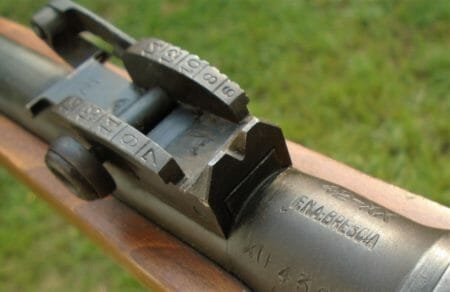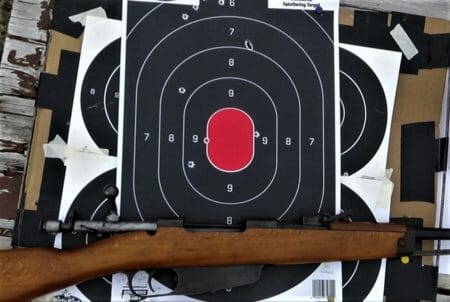
U.S.A. -(AmmoLand.com)- The Italian Carcano rifle, probably the most maligned, made fun of and possibly hated military bolt action rifles in existence. I’ve heard of them described as inaccurate, barely workable, and other terms that involve a smattering of four-letter words, but are they as bad as they’re made out to be?
When mentioning the Carcano rifle of any kind, the first thing that comes into mind is, of course, the role of the gun in the Kennedy Assassination, which happened almost twenty years after the last one was produced. The Carcano design had a long history with some three million guns produced in all of its various models. So why would such a lousy gun be in service for so long?
The design came from the mind of Salvatore Carcano, an Italian inventor who had already developed a bolt to convert the Italian Fucile Mod. 1860 muzzleloaders into breech loaders because there weren’t sufficient funds to design an entirely new gun. The Dreyse style bolt-action became the Fucile Mod. 1867 and was adopted as a stop-gap until the M1870 Vetterli came to be.
Carcano realized his bolt design still could be improved upon, so he looked at the loading system being used by Ferdinand Mannlicher, where an en-bloc clip would be fed into the gun to feed the rounds, then the empty clip ejected from the bottom when it was empty. The new gun became the Fucile di Fanteria Modello1891 or simply the Model 1891. The cartridge had been in the works since 1888 when a new smokeless round was commissioned by the Italian Army. The new 6.5 x 52mm cartridge was adopted in 1890 prior to the rifle being adopted.
While the round is known universally as the 6.5 Carcano, it officially became known as the Cartuccia Modello The 6.5 x 52mm round was in the same class as other small-bore military rounds being adopted like the 6.5 x 55mm Swedish Mauser, the 6.5 x 50mm Arisaka and the 6.5 x 53mmR Mannlicher. The 6.5 x 52mm Carcano military round had a 162-grain round nose bullet that had a muzzle velocity of 2,300 fps.
The Fucile Modello 1891 had a 30-inch barrel and used a six-round en-bloc clip, while most other rifles could only hold five in their magazines. While technically inspired by the Mannlicher design, the Carcano rifle is much closer to the German 1888 Commission Mauser, which has an en-bloc clip that is vertical, not angular like that of the 1890 Mannlicher. The 1891 rifle saw service all through World War I in the Italian Army, but other troops needed a shorter gun that could be wielded easier, and in 1893 the Moschetto Modello 91 da Cavalleria, simply known as the Cavalry carbine was introduced. This gun, still in 6.5 x 52mm had a short 17.6-inch barrel, and a fixed, barrel mounted spike bayonet. The Cavalry carbine was a full two pounds lighter than the full-length rifle and became very popular and would be reissued later in several variants.

Artillery and other non-infantry units received the Moschetto Modello 91 per Truppe Speciali starting in 1898 which had the same short barrel as the Cavalry carbine but had a full-length stock and a side-folding bayonet that proved too problematic and was later simply given an 1891 rifle bayonet.
After World War I in 1924, the Italian military took 260,000 of the 1891 rifles and modified them into Truppe Speciali short-barreled carbines. They kept the longer sight bases of the rifles and were known as Moschetto Modello 91/24. Guns that later received the shorter carbine style sight bases were named the Moschetto Modello 91/28.
Before World War II, the Italian military decided that they needed a better round than the 6.5 x 52mm along with a rifle that could be issued to all the troops, not simply one for every branch. This new gun became the Fucille Modello 91/38 rifle. The 7.35 x 61mm round was an improvement over the 6.5 x 52mm especially over longer ranges, but the problems of the design of the gun didn’t lend itself to the new round. With World War II looming on the horizon the gun and new caliber were cast aside and the 91/38 ended up with many being sold to Finland and what guns ended up in the hands of Italian troops were chambered in 6.5 x 52mm as the new cartridge was abandoned for what was already on hand.

The rest of the guns coming out of the Italian military were simply rehashes of their previous designs. The Moschetto Modello 91/38 Cavalleria was nothing more than the Cavalry carbine from World War I with fixed sights instead except for those made in Brescia which had adjustable sights that had a 200-meter battle sight when flipped forward and when flipped back were set at 450 yards and could be adjusted from 600 to 1,500 yards. They were made from 1938 until 1944.


The Moschetto Modello 91/38 Truppe Speciali likewise had fixed sights although the earliest guns were chambered in 7.35 x 61mm before the military dropped the cartridge. Make sure when you examine one of these guns you know which of the two calibers you’re getting.
The last Carcano rifle design made was the Fucile Modello 41, which was a long rifle that went back to the adjustable sights after the Italian Military began to regret only having fixed battle sights on their issued guns. The Model 41 had a 27-inch barrel and used the carbine style adjustable sights from World War I. Many of the Model 41’s didn’t enter service and can often be found in excellent condition.
The Carcano design, for all of its faults, ended up serving in conflicts after World War II, mostly in Africa, the Italian military retired theirs almost immediately after the war ended, but the Polizia de Stato and the Caribinieri kept their Moschetto Truppe Speciali 38’s until 1981.

I had heard the same stories when it came to the Carcano for years, but when a fairly clean 91/38 Cavalry carbine showed up, I decided to try it out. The gun was a Brescia made gun, so it had an adjustable sight instead of the fixed battle sight. It was a numbers-matching gun made in 1942 with a decent bore. One of the things that many shooters who aren’t familiar with it is that the 6.5 Carcano has a bore diameter of .267” while other 6.5mm rounds are all .264”, and factory loaded ammunition is no exception, leading to the inaccuracy that plagues the rifles.
One of the other issues with the Carcano is that it tends to be very picky when it comes to feeding and extracting ammunition, instead of having a magazine follower like other bolt action rifles, it relies on a spring, and that spring can keep rounds from feeding or ejecting consistently. I noticed with the Cavalry carbine that the spring was very tight, so I replaced it, which made feeding much easier.
Factory ammunition isn’t as simple as going to a big box store, but there is surplus 6.5 Carcano ammunition out there, as well as PPU and a few other companies. I found with the PPU ammunition that extraction was very hard, with the bolt sticking shut every round that was fired, then I checked the particulars of the PPU ammunition, the 123 grain SP that I had, the muzzle velocity was listed at 2,690 fps. This is pretty hot, on or above the maximum velocity for several reloading manuals, so my alternative was to hand load for it.
One thing I also noticed with the PPU loads is how high they shot over the target. Part of the problem with the Carcano is the sights, most people think that their front sight is too short for the gun, but in fact, it has to do with the way the Italians trained their soldiers. The doctrine was to put the front sight well into the notch of the rear sight, below what most of us are used to for a sight picture. It takes a lot of getting used to using the sights the way they’re supposed to be used, especially if you’ve never shot a Carcano before.
Besides the fact that the PPU ammunition shot high, it was also all over the place, it simply wouldn’t group well at all at 50 yards. It seemed at first that this gun was doomed to suffer the Carcano curse. I pulled a few of the bullets from the PPU ammo and found that they’re loaded with .264” bullets, not .267” as they should be.

Then I tried out my hand loads, these consisted of 120 grain Nosler Ballistic tips that I had lying around, which were .264” bullets instead of the .267” that is truly required. I decided to keep the loads light, and went with a minimum charge of H4895 which has a muzzle velocity close to 2,100 fps. The rounds fed much more smoothly, extracted well and the accuracy improved drastically. I also loaded some 140 grain Hornady SP’s with the same load and they proved to be just as accurate in the Carcano.

I set up another target at 50 yards and both the 140 grain and 120-grain bullets grouped consistently. While not match-grade accuracy, because the bullets are .003” smaller than they should be, I was amazed at the results. With the correct .267” bullets I think the accuracy would get even better, a lot better than the gun is given credit for.


The Carcano family of rifles has had a bad reputation for many years, and while it is certainly not the best of the military issue service rifles, it is still better than many give it credit for. With the right ammunition and in good working order, it is certainly no slouch, especially in carbine form. If you can pick one up at a decent price, they’re worth the time to try one out.
About David LaPell
David LaPell has been a Corrections Officer with the local Sheriff’s Department for thirteen years. A collector of antique and vintage firearms for over twenty years and an avid hunter. David has been writing articles about firearms, hunting, and western history for ten years. In addition to having a passion for vintage guns, he is also a fan of old trucks and has written articles on those as well.
